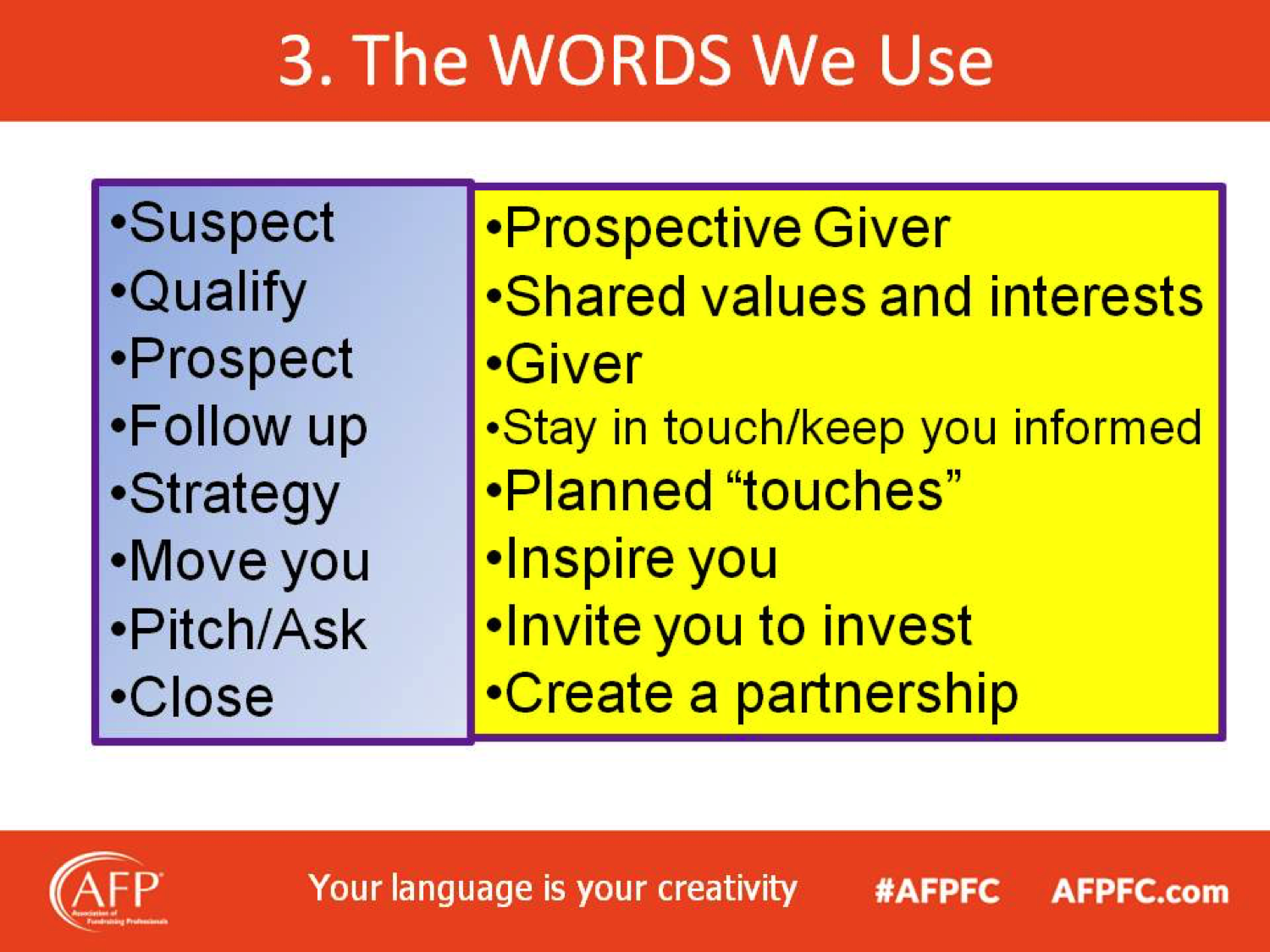
You CAN’T, and shouldn’t, do it alone.
I used to try to do it all myself. I’m smart, dedicated, passionate and pretty darn talented at creating sincere relationships that benefit all involved – personally and professional. And for sure….by the time you get someone else involved, you could do it yourself THREE times over, right?
WRONG! WRONG! WRONG!

Let’s look at our kids. Sure, we are their parents. But navigating growing up involves more than you. Here’s an example of potential “partners” that help us raise kids (and I’m sure I’ve missed some). Our kids have opinions and beliefs that are shaped and reshaped by so many others and these partners change over time. Your kids certainly pick up your values and beliefs, but you aren’t the only one influencing what choices your kids make – the good and not-so-good ones.
Creating our major giver relationships also takes partners
Spend some time thinking about ALL YOUR potential donor partners!
Ask your major donors, “Who are all the people you think about when you think about our organization?
Are you getting all these partner dots connected?

Did they volunteer before they gave? Do they know others who have deeply benefited from your services? Do they really KNOW what you do? Do they feel like they have “friends” within your organization? Is your organization a community connection for them? Are they clear on the impact various giving will have?
EVERYONE has a unique role and opportunity to be part of your organization’s culture of generosity – from the receptionist to the most major giver. Partners can help all around the Cycle of Successful Relationships.
How? Let’s take a tour
1. Consider Shared Values and Interests
People like people who are similar to themselves. So, if your board and staff think about others they know who share their values and interests, chances are they will share an interest in your organization. Don’t just ask, “Who do you know who has money?” Ask, “Who shares your values and interests and would be in a position to also want to invest in us, as you have?” This is a great way to add to your donor base.
2. Begin the Conversation
That tough 1st appointment. Are you having trouble getting that first visit? Partners open doors. BUT, they must trust that you will handle people they suggest with respect and not “Go for the ask” on the first visit. Tell your partner what you will do during this initial conversation — get acquainted, share impact of the organization, get their advice, get a deeper feel for their values and interests, what else in the community is important, look for a next step.
3. Creating a Joyful Giver
What partners will help you provide the most amazing experiences and passion for what your organization does? A student, a camper, a member of your friends group, a successful client, a staff member, a board member, another donor? And, as you engage partners more and more, they have more and more stories to tell– and they will! Brainstorm the best ways to connect and educate with your partners and ask them to take the lead. Sometimes, it seems hard to get on your major donor’s calendar. Well, an interesting partner will often make it happen! These folks ROCK at telling your story.. but more importantly, they can become a part of other givers’ lives – everyone wins. Think about it… don’t you tend to go with a friend to volunteer or attend an event? Help create these friendships.
4. Making an Artful Ask 
Partners may be a good fit for smaller asks, but 95% of all board members and other partners HATE this piece. Frankly, it is ALL they think about when they hear the word “fundraising.” I believe you will be so much more successful if you just take them out of this piece EXCEPT to go with you to share why THEY give. Let the professional speak the Ask.
5. Being a Grateful Recipient
This is THE BEST PLACE to engage your partners! As development professionals, we often have grand intentions of elaborate (or ANY for that fact) thank you experiences, but we just don’t get them done. Get a few partners together and explore, “What can we do so that our donors are crystal clear on just how very much we appreciate their giving?” and brainstorm. Ask if they might be comfortable taking that appreciation step themselves. Bingo! They will get the hang of it – taking you far beyond the thank you note or phone call. It’s exciting and important because the donor deserves to enjoy the giving! (And sure, great stewardship also leads a donor to ask, “What else do you need?” which takes us to the next giving opportunity!)
Now, what do YOU need to do?
1. Change your mindset about using partners from, “It’s a bunch of wasted time” to “It helps me best engage my donors.” Make this a priority!
2. Be patient. Yes, it can take a long time to get a board member or another staff member to help at first. It’s worth it.
3. Complete the circle. Be sure when you ask others to be a part of this, you stay in touch with them about the progress.
4. When you tell donor stories, mention everyone involved – from the receptionist to the Top Dog.
5. BELIEVE THIS – It better serves your donors to have multiple connections to your organization… beyond you. It’s sort of a power move by some major giving officers to want to be the only one. That’s not best for the donor or the non-profit.
6. Educate your partners on the power of their partnership. Show them my cycle and explain how they don’t have to ask for money to really help you! Every time your colleagues do their work well, relationships are built.
7. Remember that your partners are benefiting too!
8. Get going! Right now – mid-year – is when you need to be making GREAT visits to set the stage for year-end asks. Get these appointments done. It will give you a comfortable and wildly successful year end!
Invest in Joy!









 Our brains get fried. We become mentally exhausted. There is a mindset
Our brains get fried. We become mentally exhausted. There is a mindset 




